What Influences the Cross-Border Air Pollutant Transfer in China–United States Trade: A Comparative Analysis Using the Extended IO-SDA Method
Abstract
1. Introduction
2. Literature Review
3. Methodology
4. Data Sources
5. Results and Discussion
5.1. The Status of CBAPT in China–US Trade
5.2. Influencing Factors for CBAPT in China–US Trade
5.2.1. Energy Intensity Effect
5.2.2. Emission Coefficient Effect
5.2.3. Trade Structure Effect
5.2.4. Trade Scale Effect
6. Conclusions and Policy Suggestions
Author Contributions
Funding
Conflicts of Interest
References
- Wiedmann, T.; Lenzen, M. Environ. and social footprints of international trade. Nat. Geosci. 2018, 11, 314–321. [Google Scholar] [CrossRef]
- Xu, S.C.; Gao, C.; Miao, Y.M.; Shen, W.X.; Long, R.Y.; Chen, H.; Zhao, B.; Wang, S.X. Calculation and decomposition of Chin’s embodied air pollutants in Sino-US trade. J. Clean. Prod. 2019, 209, 978–994. [Google Scholar] [CrossRef]
- Aunan, K.; Hansen, M.H.; Liu, Z.H.; Wang, S.X. The hidden hazard of household air pollution in rural China. Environ. Sci. Policy 2019, 93, 27–33. [Google Scholar] [CrossRef]
- Sun, C.W.; Yuan, X.; Yao, X. Social acceptance towards the air pollution in China: Evidence from public’s willingness to pay for smog mitigation. Energy Policy 2016, 92, 313–324. [Google Scholar] [CrossRef]
- Zeng, Y.Y.; Cao, Y.F.; Qiao, X.; Seyler, B.C.; Tang, Y. Air pollution reduction in China: Recent success but great challenge for the future. Sci. Total Environ. 2019, 663, 329–337. [Google Scholar] [CrossRef]
- Sato, M. Embodied carbon in trade: A survey of the empirical literature. J. Econ. Surv. 2014, 28, 831–861. [Google Scholar] [CrossRef]
- Wiedmann, T. Impacts embodied in global trade flows. In Taking Stock of Industrial Ecology; Clift, R., Druckman, A., Eds.; Springer: Berlin/Heidelberg, Germany, 2016; pp. 159–180. [Google Scholar]
- Leontief, W. Environ. repercussions and the economic structure: An Input-output approach. Rev. Econ. Stat. 1970, 52, 262–271. [Google Scholar] [CrossRef]
- Fang, D.L.; Chen, B. Information-based ecological network analysis for embodied carbon network in China. Energy Procedia 2016, 104, 574–579. [Google Scholar] [CrossRef]
- Wang, Z.H.; Yang, Y.T.; Wang, B. Carbon footprints and embodied CO2 transfers among provinces in China. Renew. Sustain. Energy Rev. 2018, 82, 1068–1078. [Google Scholar] [CrossRef]
- Zhao, Y.H.; Tian, Y.; Liu, Y. Input-output analysis of carbon emissions embodied in India’s foreign trade. J. Int. Trade 2014, 10, 77–87. [Google Scholar]
- Seo, S.; Kim, J.; Yum, K.-K.; McGregor, J. Embodied carbon of building products during their supply chains: Case study of aluminium window in Australia. Resour. Conserv. Recycl. 2015, 105, 160–166. [Google Scholar] [CrossRef]
- Duggan, A.R.; McCabe, B.A.; Goggins, J.; Clifford, E. An embodied carbon and embodied energy appraisal of a section of Irish motorway constructed in peatlands. Constr. Build. Mater. 2015, 79, 402–419. [Google Scholar] [CrossRef]
- Andersson, M.; Barkander, J.; Kono, J.; Ostermeyer, Y. Abatement cost of embodied emissions of a residential building in Sweden. Energy Build. 2018, 158, 595–604. [Google Scholar] [CrossRef]
- Deng, G.Y.; Ding, Y.F.; Ren, S.L. The study on the air pollutants embodied in goods for consumption and trade in China-Accounting and structural decomposition analysis. J. Clean. Prod. 2016, 135, 332–341. [Google Scholar] [CrossRef]
- Su, X. China’s Air Pollutant Emission Embodied in International Trade; Tsinghua University: Beijing, China, 2013; pp. 21–36. [Google Scholar]
- Yang, X.; Zhang, W.Z.; Fan, J.; Li, J.M.; Meng, J. The temporal variation of SO2 emissions embodied in Chinese supply chains, 2002–2012. Environ. Pollut. 2018, 241, 172–181. [Google Scholar] [CrossRef]
- Wakeel, M.; Yang, S.Y.; Chen, B.; Hayat, T.; Alsaedi, A.; Ahmad, B. Network perspective of embodied PM2.5-A case study. J. Clean. Prod. 2017, 142, 3322–3331. [Google Scholar] [CrossRef]
- Tukker, A.; Giljum, S.; Wood, R. Recent progress in assessment of resource efficiency and environmental impacts embodied in trade: An introduction to this special issue. J. Ind. Ecol. 2018, 22, 489–501. [Google Scholar] [CrossRef]
- Cadarso, M.Á.; Monsalve, F.; Arce, G. Emissions burden shifting in global value chains-winners and losers under multi-regional versus bilateral accounting. Econ. Syst. Res. 2018, 30, 439–461. [Google Scholar] [CrossRef]
- Dong, Y.L.; Ishikawa, M.; Liu, X.B.; Wang, C. An analysis of the driving forces of CO2 emissions embodied in Japan-China trade. Energy Policy 2010, 38, 6784–6792. [Google Scholar] [CrossRef]
- Liu, X.B.; Ishikawa, M.; Wang, C.; Dong, Y.L.; Liu, W.L. Analyses of CO2 emissions embodied in Japan-China trade. Energy Policy 2010, 38, 1510–1518. [Google Scholar] [CrossRef]
- Wu, R.; Geng, Y.; Dong, H.J.; Fujita, T.; Tian, X. Changes of CO2 emissions embodied in China-Japan trade: Drivers and implications. J. Clean. Prod. 2016, 112, 4151–4158. [Google Scholar] [CrossRef]
- Long, R.Y.; Li, J.Q.; Chen, H.; Zhang, L.L.; Li, Q.W. Embodied carbon dioxide flow in international trade: A comparative analysis based on China and Japan. J. Environ. Manag. 2018, 209, 371–381. [Google Scholar] [CrossRef] [PubMed]
- Yu, Y.; Chen, F.F. Research on carbon emissions embodied in trade between China and South Korea. Atmos. Pollut. Res. 2017, 8, 56–63. [Google Scholar] [CrossRef]
- Jayanthakumaran, K.; Liu, Y. Bi-lateral CO2 emissions embodied in Australia-China trade. Energy Policy 2016, 92, 205–213. [Google Scholar] [CrossRef]
- Du, H.B.; Guo, J.H.; Mao, G.Z.; Smith, A.M.; Wang, X.X.; Wang, Y. CO2 emissions embodied in China-US trade: Input-output analysis based on the emergy/dollar ratio. Energy Policy 2011, 39, 5980–5987. [Google Scholar] [CrossRef]
- Zhao, Y.H.; Wang, S.; Zhang, Z.H.; Liu, Y.; Ahamd, A. Driving factors of carbon emissions embodied in China-US trade: A structural decomposition analysis. J. Clean. Prod. 2016, 131, 678–689. [Google Scholar] [CrossRef]
- Deng, G.Y.; Xu, Y. Accounting and structure decomposition analysis of embodied carbon trade: A global perspective. Energy 2017, 137, 140–151. [Google Scholar] [CrossRef]
- Liu, Y.; Chen, S.Y.; Chen, B.; Yang, W. Analysis of CO2 emissions embodied in China’s bilateral trade: A non-competitive import input-output approach. J. Clean. Prod. 2017, 163, S410–S419. [Google Scholar] [CrossRef]
- Xu, S.C.; Han, H.M.; Zhang, W.W.; Zhang, Q.Q.; Long, R.Y.; Chen, H.; He, Z.X. Analysis of regional contributions to the national carbon intensity in China in different Five-Year Plan periods. J. Clean. Prod. 2017, 145, 209–220. [Google Scholar] [CrossRef]
- Su, B.; Thomson, E. China’s carbon emissions embodied in (normal and processing) exports and their driving forces, 2006–2012. Energy Econ. 2016, 59, 414–422. [Google Scholar] [CrossRef]
- Zhong, Z.Q.; He, L.Y.; Wang, Z. Geographic sources and the structural decomposition of emissions embodied in trade by Chinese megacities: The case of Beijing, Tianjin, Shanghai, and Chongqing. J. Clean. Prod. 2017, 158, 59–72. [Google Scholar] [CrossRef]
- Zhou, D.Q.; Zhou, X.Y.; Xu, Q.; Wu, F.; Wang, Q.W.; Zha, D.L. Regional embodied carbon emissions and their transfer characteristics in China. Struct. Chang. Econ. Dyn. 2018, 46, 180–193. [Google Scholar] [CrossRef]
- Xu, Y.; Dietzenbacher, E. A Structural decomposition analysis of the emissions embodied in trade. Ecol. Econ. 2014, 101, 10–20. [Google Scholar] [CrossRef]
- Pu, Z.N.; Fu, J.S.; Zhang, C.; Shao, J. Structural decomposition analysis of embodied carbon from transition economies. Technol. Forecast. Soc. Chang. 2018, 135, 1–12. [Google Scholar] [CrossRef]
- Liu, Q.L.; Wang, Q. Reexamine SO2 emissions embodied in China’s exports using multiregional input-output analysis. Ecol. Econ. 2015, 113, 39–50. [Google Scholar] [CrossRef]
- Lin, B.Q.; Xu, M.M. Does China become the “pollution heaven” in South-South trade? Evidence from Sino-Russian trade. Sci. Total Environ. 2019, 666, 964–974. [Google Scholar] [CrossRef] [PubMed]
- Wang, H.; Ang, B.W.; Su, B. Assessing drivers of economy-wide energy use and emissions: IDA versus SDA. Energy Policy 2017, 107, 585–599. [Google Scholar] [CrossRef]
- Dietzenbacher, E.; Los, B. Structural Decomposition Techniques: Sense and Sensitivity. Econ. Syst. Res. 1998, 10, 307–324. [Google Scholar] [CrossRef]
- Zhao, B.; Wang, S.X.; Dong, X.Y.; Wang, J.D.; Duan, L.; Fu, X.; Hao, J.M.; Fu, J. Environ. effects of the recent emission changes in China: Implications for particulate matter pollution and soil acidification. Environ. Res. Lett. 2013, 8, 024031. [Google Scholar] [CrossRef]
- Zhao, B.; Wang, S.X.; Liu, H.; Xu, J.Y.; Fu, K.; Klimont, Z.; Hao, J.M.; He, K.B.; Cofala, J.; Amann, M. NOx emissions in China: Historical trends and future perspectives. Atmos. Chem. Phys. 2013, 13, 9869–9897. [Google Scholar] [CrossRef]
- Zhao, B.; Wang, S.X.; Wang, J.D.; Fu, J.S.; Liu, T.H.; Xu, J.Y.; Fu, X.; Hao, J.M. Impact of national NOx and SO2 control policies on particulate matter pollution in China. Atmos. Environ. 2013, 77, 453–463. [Google Scholar] [CrossRef]
- Tao, F.; Xu, Z.; Duncan, A.A.; Xia, X.H.; Wu, X.F.; Li, J.Y. Driving forces of energy embodied in China-EU manufacturing trade from 1995 to 2011. Resour. Conserv. Recycl. 2018, 136, 324–334. [Google Scholar] [CrossRef]
- Yu, S.W.; Wei, Y.M.; Guo, H.X.; Ding, L.P. Carbon emission coefficient measurement of the coal-to-power energy chain in China. Appl. Energy 2014, 114, 290–300. [Google Scholar] [CrossRef]
- Xu, S.C.; Miao, Y.M.; Gao, C.; Long, R.Y.; Chen, H.; Zhao, B.; Wang, S.X. Regional differences in impacts of economic growth and urbanization on air pollutants in China based on provincial panel estimation. J. Clean. Prod. 2019, 208, 340–352. [Google Scholar] [CrossRef]
- Xu, S.C.; Zhang, W.W.; Li, Q.B.; Zhao, B.; Wang, S.X.; Long, R.Y. Decomposition analysis of the factors that influence energy related air pollutant emission changes in China using the SDA method. Sustainability 2017, 9, 1742. [Google Scholar] [CrossRef]
- Barkhordari, S.; Fattahi, M. Reform of energy prices, energy intensity and technology: A case study of Iran (ARDL approach). Energy Strategy Rev. 2017, 18, 18–23. [Google Scholar] [CrossRef]
- Yang, R.R.; Long, R.Y.; Yue, T.; Shi, H.H. Calculation of embodied energy in Sino-USA trade: 1997–2011. Energy Policy 2014, 72, 110–119. [Google Scholar] [CrossRef]

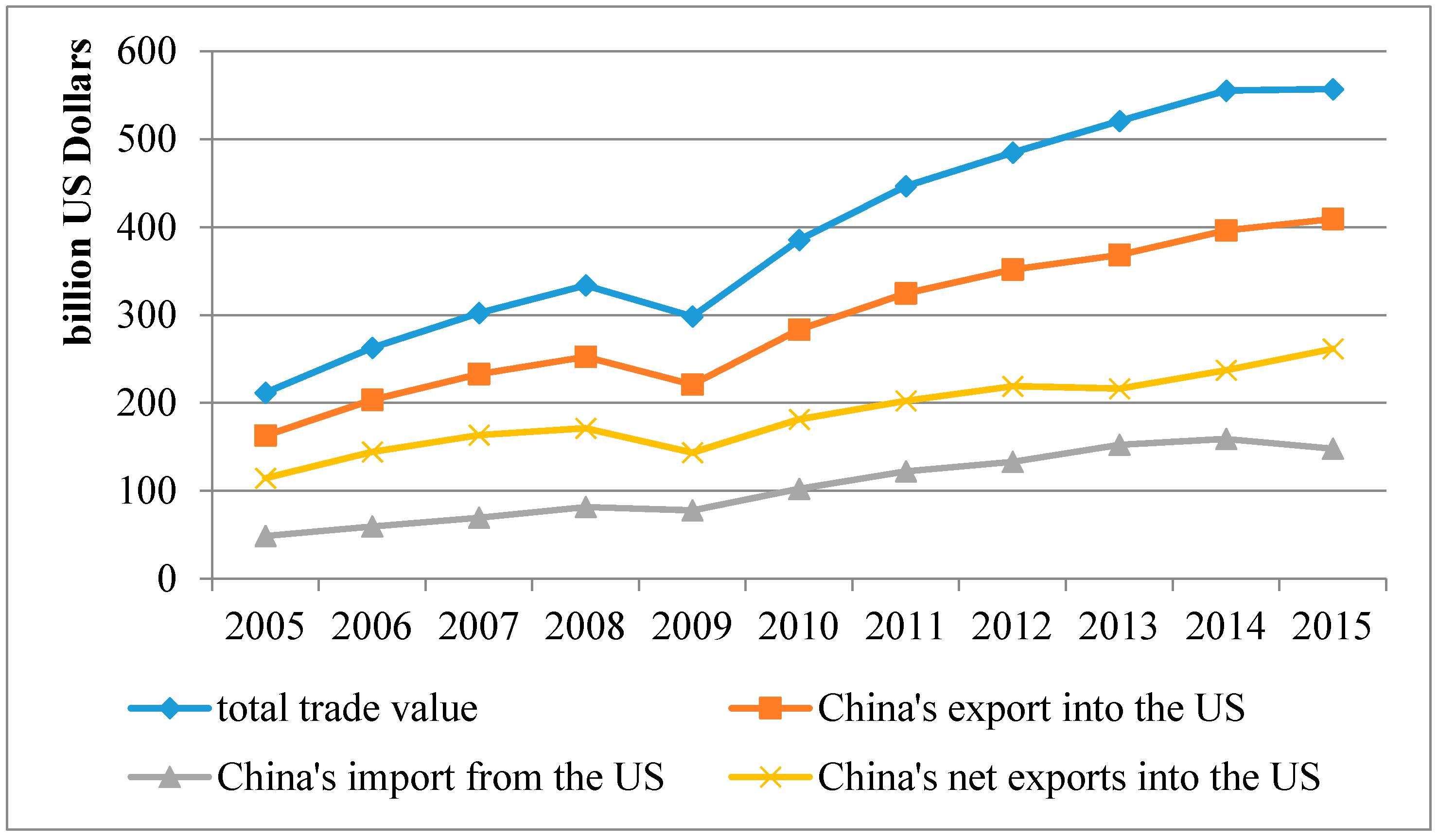

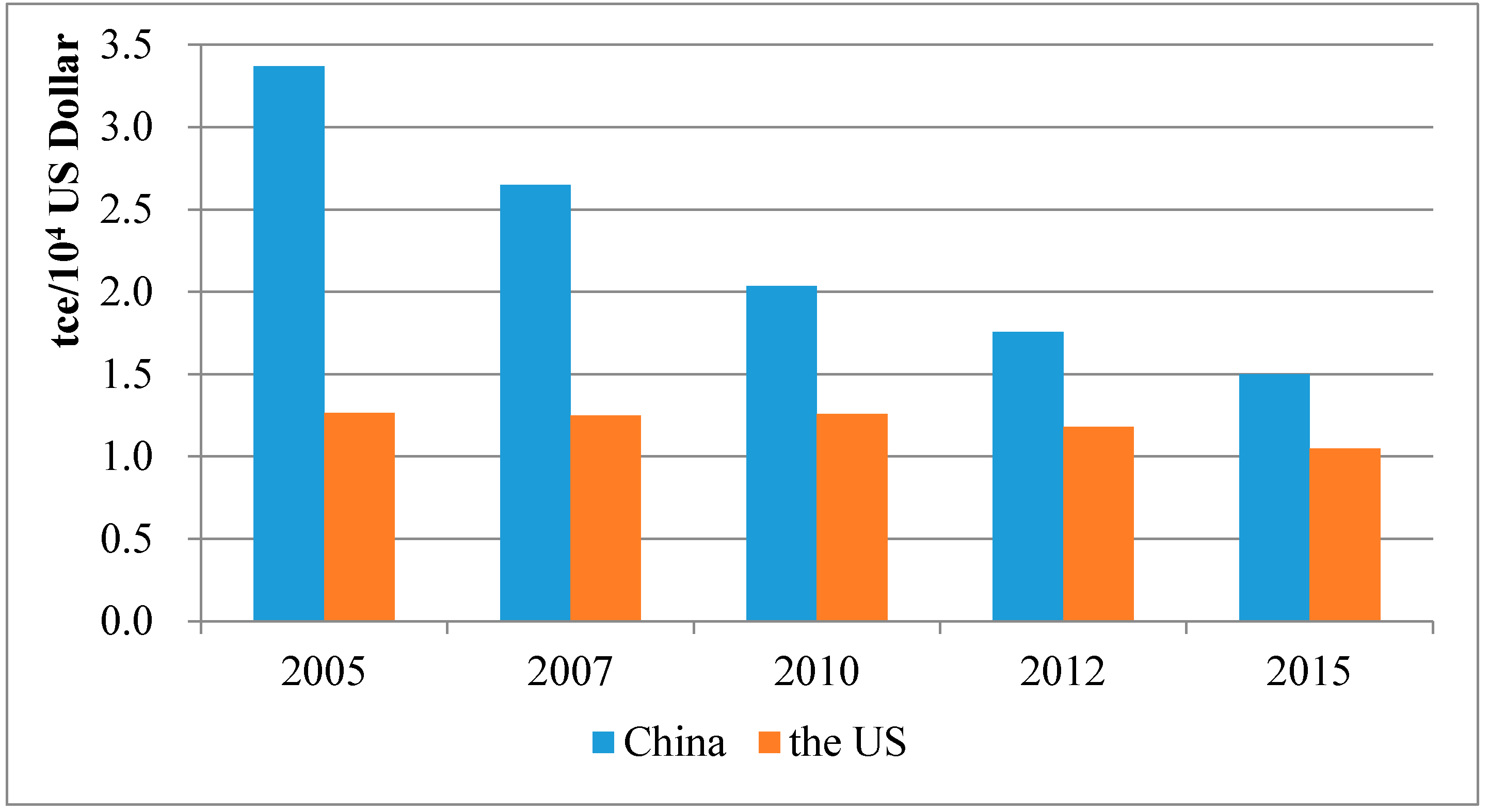
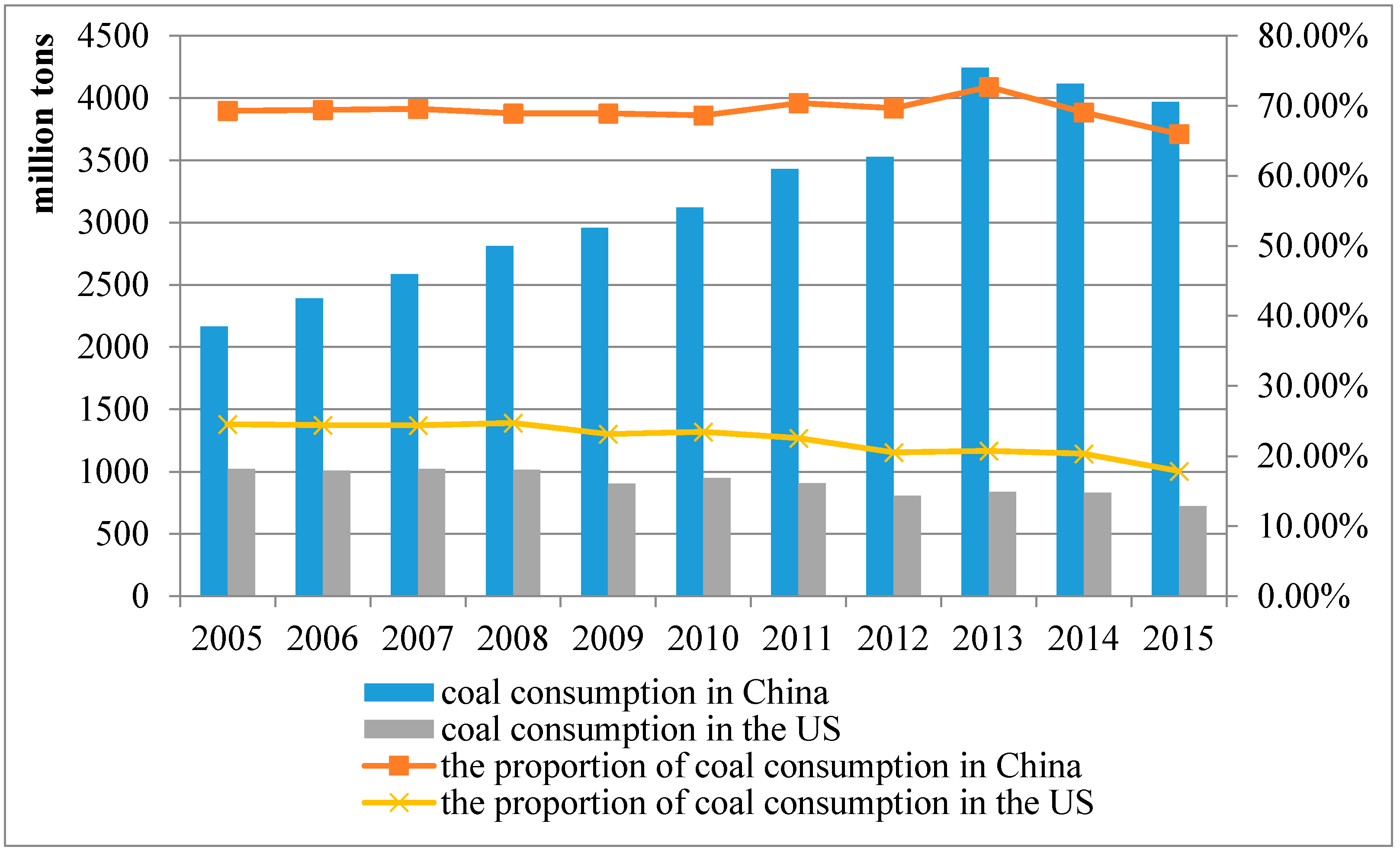
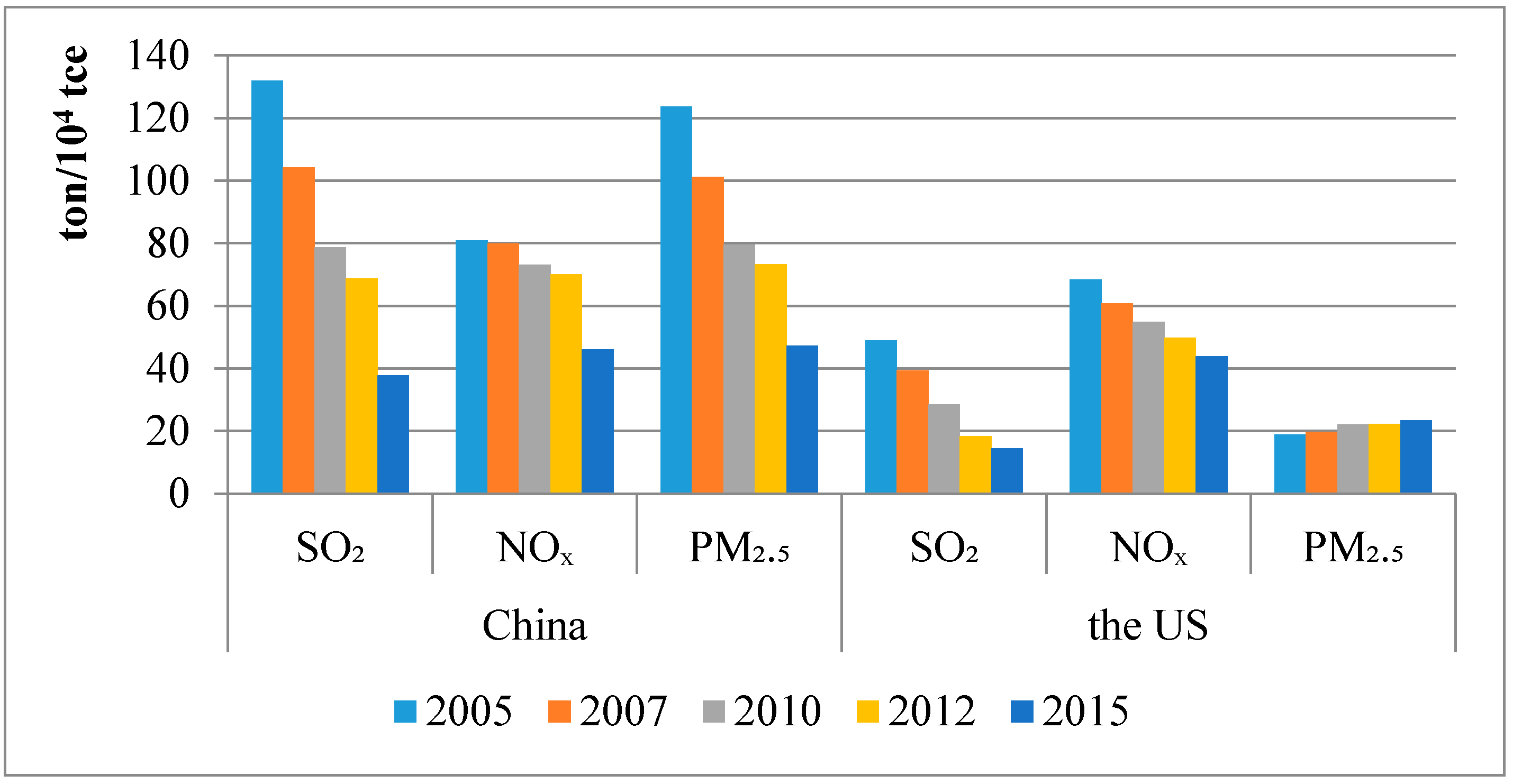
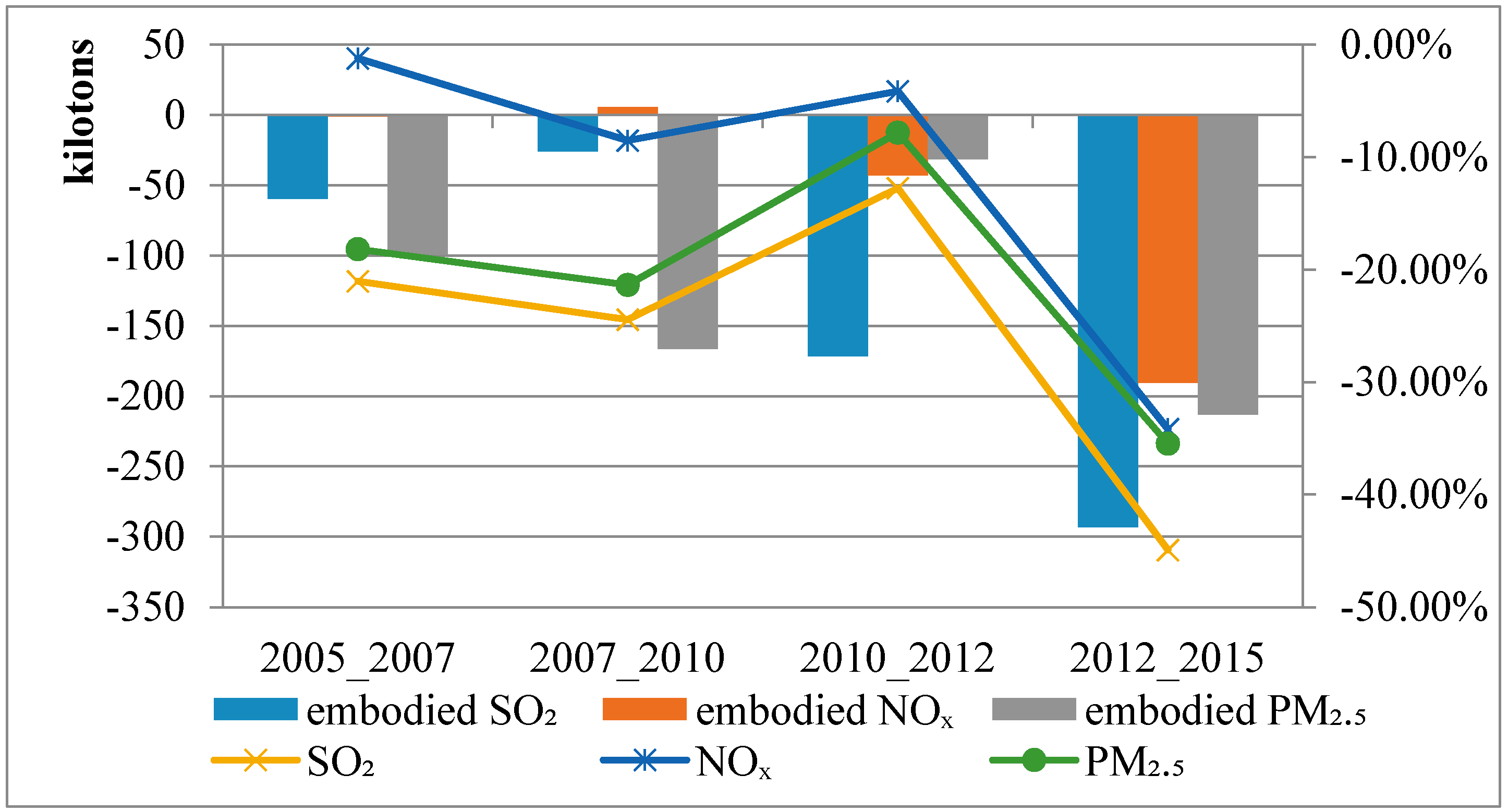
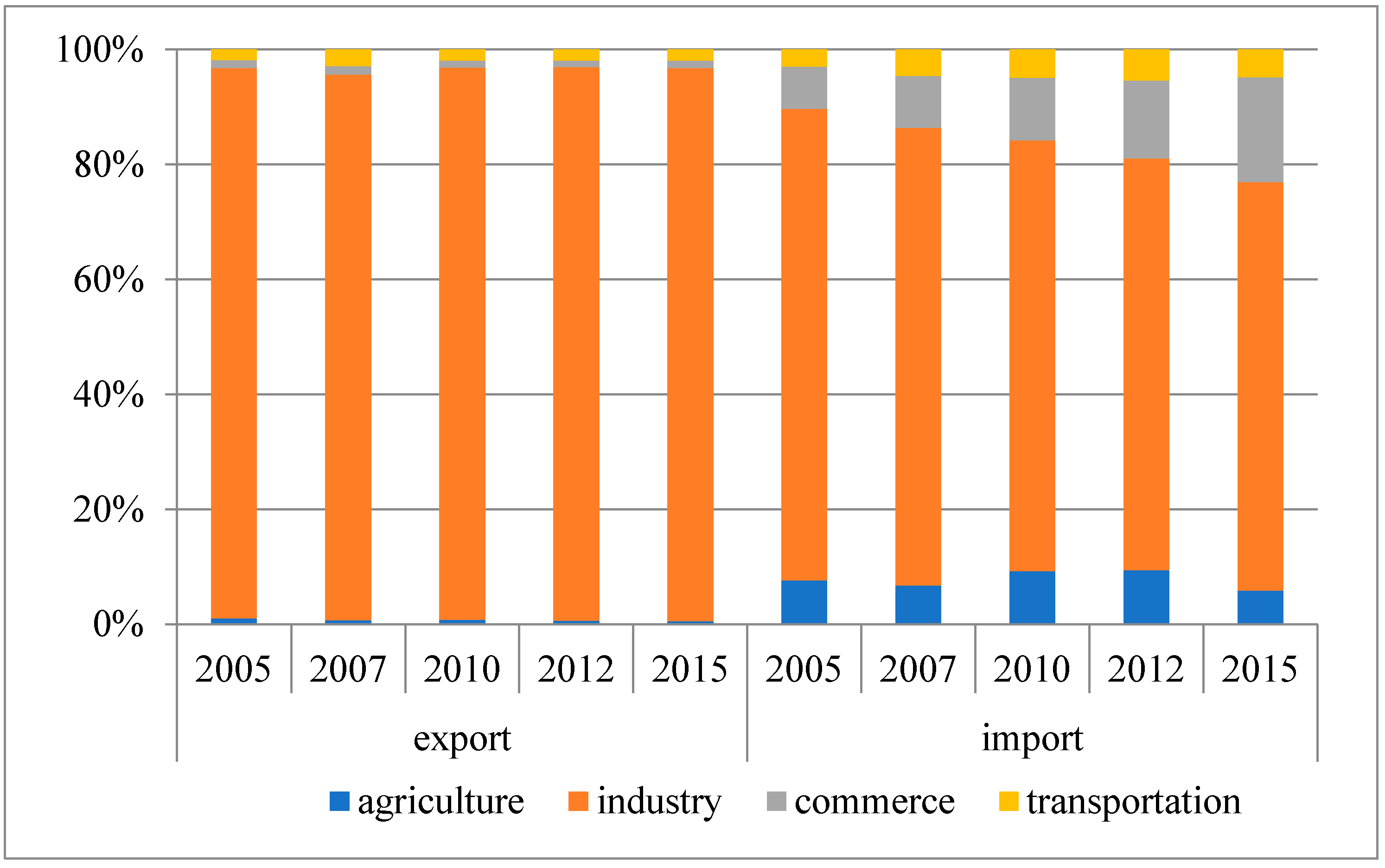
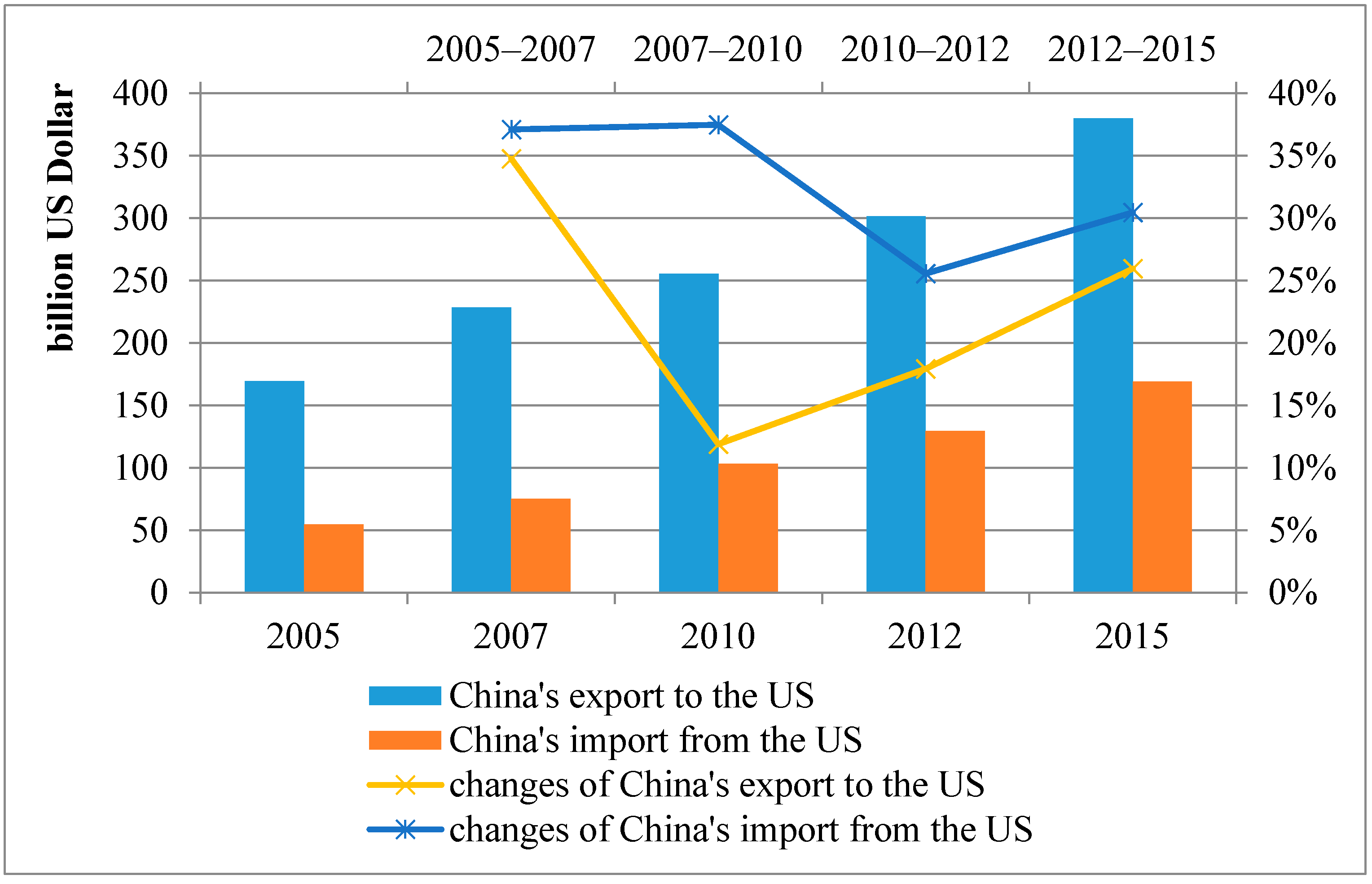
| Sector Code | Sector |
|---|---|
| Sector 1 | Agriculture, forestry, animal husbandry, and fishery |
| Sector 2 | Metal manufacture |
| Sector 3 | Non-metallic mineral products |
| Sector 4 | Coke and refined petroleum |
| Sector 5 | Chemical industry |
| Sector 6 | Mining and quarrying |
| Sector 7 | Food manufacture |
| Sector 8 | Textile manufacture |
| Sector 9 | Paper manufacture |
| Sector 10 | Other industries |
| Sector 11 | Commerce |
| Sector 12 | Transportation |
| Year | Sector Code | China | The US | Export into the US | Import from the US | ||||
|---|---|---|---|---|---|---|---|---|---|
| Embodied SO2 | Embodied NOx | Embodied PM2.5 | Embodied SO2 | Embodied NOx | Embodied PM2.5 | ||||
| 2005 | Sector 1 | 0.05 | 0.44 | 0.09 | 0.08 | 0.61 | 2.00 | 1.78 | 4.20 |
| Sector 2 | 2.42 | 0.33 | 3.54 | 0.08 | 0.03 | 0.03 | 12.23 | 3.31 | |
| Sector 3 | 1.55 | 2.43 | 14.11 | 0.30 | 0.31 | 0.03 | 2.14 | 0.29 | |
| Sector 4 | 0.38 | 0.08 | 0.83 | 0.02 | 0.03 | 0.00 | 1.08 | 0.48 | |
| Sector 5 | 1.95 | 0.02 | 0.00 | 0.13 | 0.03 | 0.02 | 4.47 | 5.54 | |
| Sector 6 | 0.23 | 0.04 | 0.36 | 0.19 | 0.20 | 0.02 | 1.59 | 0.98 | |
| Sector 7 | 0.44 | 0.03 | 0.46 | 0.09 | 0.09 | 0.01 | 1.19 | 0.31 | |
| Sector 8 | 7.83 | 0.83 | 3.82 | 4.18 | 4.38 | 0.47 | 28.18 | 3.06 | |
| Sector 9 | 3.45 | 0.16 | 2.06 | 2.13 | 2.23 | 0.24 | 1.16 | 2.22 | |
| Sector 10 | 33.87 | 15.82 | 13.00 | 2.05 | 2.89 | 2.32 | 110.33 | 28.74 | |
| Sector 11 | 0.04 | 0.01 | 0.11 | 0.00 | 0.00 | 0.01 | 2.30 | 4.00 | |
| Sector 12 | 0.16 | 2.30 | 0.13 | 0.02 | 0.36 | 0.02 | 3.07 | 1.62 | |
| 2007 | Sector 1 | 0.05 | 0.43 | 0.09 | 0.08 | 0.61 | 1.98 | 1.54 | 5.05 |
| Sector 2 | 1.94 | 0.31 | 3.13 | 0.31 | 0.13 | 0.11 | 15.58 | 3.83 | |
| Sector 3 | 1.56 | 2.69 | 11.32 | 0.39 | 0.46 | 0.05 | 2.69 | 0.41 | |
| Sector 4 | 0.29 | 0.05 | 0.62 | 0.01 | 0.03 | 0.00 | 1.03 | 0.54 | |
| Sector 5 | 2.50 | 0.02 | 0.00 | 0.13 | 0.03 | 0.01 | 5.77 | 7.11 | |
| Sector 6 | 0.22 | 0.04 | 0.20 | 0.16 | 0.19 | 0.02 | 1.40 | 1.34 | |
| Sector 7 | 0.58 | 0.04 | 0.38 | 0.17 | 0.21 | 0.02 | 2.38 | 0.49 | |
| Sector 8 | 5.30 | 0.82 | 2.51 | 4.44 | 5.30 | 0.56 | 35.87 | 3.57 | |
| Sector 9 | 4.58 | 0.20 | 2.27 | 2.61 | 3.11 | 0.33 | 1.89 | 3.22 | |
| Sector 10 | 28.90 | 14.10 | 9.42 | 2.38 | 4.05 | 3.39 | 150.48 | 39.25 | |
| Sector 11 | 0.04 | 0.01 | 0.10 | 0.00 | 0.00 | 0.03 | 3.29 | 6.79 | |
| Sector 12 | 0.18 | 2.30 | 0.11 | 0.02 | 0.63 | 0.03 | 6.51 | 3.44 | |
| 2010 | Sector 1 | 0.09 | 0.75 | 0.12 | 0.23 | 1.73 | 5.61 | 2.03 | 9.53 |
| Sector 2 | 1.14 | 0.24 | 1.98 | 0.19 | 0.09 | 0.07 | 12.21 | 4.84 | |
| Sector 3 | 0.95 | 2.33 | 5.63 | 0.74 | 1.19 | 0.18 | 3.14 | 0.72 | |
| Sector 4 | 0.14 | 0.03 | 0.17 | 0.01 | 0.04 | 0.00 | 0.55 | 0.76 | |
| Sector 5 | 1.00 | 0.01 | 0.00 | 0.55 | 0.20 | 0.07 | 8.31 | 9.90 | |
| Sector 6 | 0.06 | 0.02 | 0.06 | 0.17 | 0.28 | 0.04 | 0.89 | 2.41 | |
| Sector 7 | 0.32 | 0.03 | 0.21 | 0.31 | 0.51 | 0.08 | 2.30 | 1.33 | |
| Sector 8 | 4.01 | 0.99 | 2.02 | 4.03 | 6.52 | 0.98 | 45.21 | 3.82 | |
| Sector 9 | 2.34 | 0.15 | 0.93 | 2.93 | 4.74 | 0.72 | 2.32 | 4.28 | |
| Sector 10 | 23.29 | 11.23 | 5.21 | 2.83 | 6.17 | 5.34 | 170.80 | 49.23 | |
| Sector 11 | 0.03 | 0.00 | 0.07 | 0.00 | 0.00 | 0.05 | 3.06 | 11.27 | |
| Sector 12 | 0.07 | 0.85 | 0.03 | 0.02 | 0.97 | 0.04 | 4.80 | 5.03 | |
| 2012 | Sector 1 | 0.06 | 0.51 | 0.08 | 0.23 | 1.75 | 5.70 | 1.86 | 12.19 |
| Sector 2 | 0.78 | 0.18 | 1.66 | 0.18 | 0.10 | 0.06 | 14.76 | 5.99 | |
| Sector 3 | 1.11 | 2.67 | 5.42 | 0.39 | 0.73 | 0.13 | 3.84 | 0.69 | |
| Sector 4 | 0.15 | 0.03 | 0.18 | 0.00 | 0.03 | 0.00 | 0.71 | 0.99 | |
| Sector 5 | 1.73 | 0.01 | 0.00 | 0.16 | 0.07 | 0.02 | 10.07 | 10.64 | |
| Sector 6 | 0.07 | 0.02 | 0.07 | 0.10 | 0.18 | 0.03 | 1.03 | 2.88 | |
| Sector 7 | 0.30 | 0.03 | 0.20 | 0.22 | 0.40 | 0.07 | 2.97 | 1.60 | |
| Sector 8 | 3.71 | 0.78 | 1.87 | 3.37 | 6.22 | 1.15 | 49.96 | 5.55 | |
| Sector 9 | 3.59 | 0.19 | 1.42 | 2.21 | 4.08 | 0.75 | 3.03 | 5.26 | |
| Sector 10 | 15.44 | 8.61 | 4.33 | 2.56 | 6.37 | 5.72 | 204.17 | 59.19 | |
| Sector 11 | 0.02 | 0.00 | 0.05 | 0.00 | 0.01 | 0.10 | 3.25 | 17.54 | |
| Sector 12 | 0.04 | 0.55 | 0.02 | 0.02 | 1.19 | 0.05 | 5.78 | 6.98 | |
| 2015 | Sector 1 | 0.03 | 0.53 | 0.05 | 0.16 | 1.20 | 3.90 | 1.96 | 9.98 |
| Sector 2 | 0.34 | 0.19 | 1.53 | 0.25 | 0.17 | 0.11 | 19.60 | 8.41 | |
| Sector 3 | 0.74 | 2.32 | 2.51 | 0.64 | 1.16 | 0.24 | 6.37 | 0.89 | |
| Sector 4 | 0.08 | 0.02 | 0.09 | 0.01 | 0.11 | 0.00 | 0.76 | 2.38 | |
| Sector 5 | 0.10 | 0.00 | 0.00 | 1.15 | 0.47 | 0.14 | 12.22 | 12.33 | |
| Sector 6 | 0.05 | 0.01 | 0.05 | 0.24 | 0.43 | 0.09 | 1.34 | 4.55 | |
| Sector 7 | 0.24 | 0.02 | 0.16 | 0.52 | 0.95 | 0.19 | 2.72 | 2.77 | |
| Sector 8 | 3.50 | 0.67 | 1.77 | 2.71 | 4.90 | 0.99 | 61.39 | 3.25 | |
| Sector 9 | 1.81 | 0.09 | 0.72 | 3.01 | 5.45 | 1.10 | 4.43 | 5.20 | |
| Sector 10 | 14.83 | 6.25 | 4.37 | 2.07 | 5.97 | 5.69 | 256.91 | 80.28 | |
| Sector 11 | 0.02 | 0.00 | 0.06 | 0.00 | 0.01 | 0.14 | 4.76 | 30.77 | |
| Sector 12 | 0.03 | 0.51 | 0.01 | 0.01 | 1.01 | 0.05 | 7.24 | 8.13 | |
| EAPs | Effect | Value (Unit: kt) | Proportion (Unit: %) | ||||||||
|---|---|---|---|---|---|---|---|---|---|---|---|
| 2005–2007 | 2007–2010 | 2010–2012 | 2012–2015 | 2005–2015 | 2005–2007 | 2007–2010 | 2010–2012 | 2012–2015 | 2005–2015 | ||
| embodied SO2 | China energy intensity | −86.9 | −68.7 | −34.6 | 82.5 | −107.7 | −216.2 | −63.7 | −27.0 | 117.9 | −40.5 |
| China emission coefficient | −59.4 | −25.9 | −171.7 | −293.1 | −550.0 | −147.9 | −24.0 | −134.2 | −418.7 | −207.0 | |
| export structure | −4.1 | −12.9 | 10.2 | 9.8 | 3.0 | −10.2 | −12.0 | 8.0 | 14.0 | 1.1 | |
| export scale | 191.0 | −3.1 | 66.3 | 130.8 | 385.0 | 475.4 | −2.9 | 51.8 | 187.0 | 144.9 | |
| US energy intensity | 1.9 | 7.5 | −5.7 | 11.7 | 15.3 | 4.7 | 7.0 | −4.5 | 16.7 | 5.8 | |
| US emission coefficient | 3.8 | −0.6 | 9.8 | −7.4 | 5.7 | 9.5 | −0.5 | 7.7 | −10.6 | 2.1 | |
| import structure | −0.2 | 0.6 | 1.0 | 0.8 | 2.2 | −0.5 | 0.5 | 0.8 | 1.2 | 0.8 | |
| import scale | −5.9 | −4.8 | −3.3 | −5.1 | −19.2 | −14.8 | −4.4 | −2.6 | −7.3 | −7.2 | |
| total effects | 40.2 | −107.9 | −127.9 | −70.0 | −265.7 | 100.0 | −100.0 | −100.0 | −100.0 | −100.0 | |
| embodied NOx | China energy intensity | −67.0 | −15.5 | −35.5 | 57.6 | −60.5 | −542.7 | −29.2 | −65.9 | 182.5 | −47.9 |
| China emission coefficient | −0.9 | 5.8 | −43.0 | −190.6 | −228.8 | −7.1 | 10.8 | −79.8 | −604.4 | −181.1 | |
| export structure | 17.5 | −13.1 | 5.5 | 22.7 | 32.6 | 141.9 | −24.6 | 10.1 | 72.1 | 25.8 | |
| export scale | 89.3 | −1.6 | 35.7 | 74.3 | 197.8 | 723.5 | −2.9 | 66.2 | 235.7 | 156.6 | |
| US energy intensity | 2.6 | −11.2 | −0.4 | 2.4 | −6.5 | 21.3 | −21.0 | −0.7 | 7.6 | −5.2 | |
| US emission coefficient | 4.6 | 4.7 | 9.6 | 23.0 | 42.0 | 37.3 | 8.9 | 17.8 | 73.0 | 33.2 | |
| import structure | −17.6 | −3.1 | −7.1 | 11.0 | −16.7 | −142.2 | −5.8 | −13.1 | 34.8 | −13.2 | |
| import scale | −16.3 | −19.3 | −18.7 | −31.9 | −86.2 | −132.0 | −36.2 | −34.7 | −101.3 | −68.3 | |
| total effects | 12.3 | −53.2 | −53.9 | −31.5 | −126.3 | 100.0 | −100.0 | −100.0 | −100.0 | −100.0 | |
| embodied PM2.5 | China energy intensity | −69.3 | 24.3 | −44.0 | 22.1 | −66.9 | −150.3 | 11.8 | −166.3 | 37.5 | −19.9 |
| China emission coefficient | −99.4 | −166.5 | −31.3 | −213.1 | −510.2 | −215.7 | −81.2 | −118.3 | −360.9 | −151.6 | |
| export structure | −26.8 | −53.3 | 10.2 | 46.7 | −23.3 | −58.2 | −26.0 | 38.5 | 79.0 | −6.9 | |
| export scale | 153.7 | −2.2 | 42.8 | 90.7 | 285.0 | 333.5 | −1.1 | 161.8 | 153.6 | 84.7 | |
| US energy intensity | 2.0 | 2.0 | −1.7 | −3.0 | −0.7 | 4.4 | 1.0 | −6.5 | −5.1 | −0.2 | |
| US emission coefficient | −1.2 | −4.3 | 2.2 | 4.7 | 1.4 | −2.6 | −2.1 | 8.4 | 8.0 | 0.4 | |
| import structure | −0.4 | 0.0 | 0.3 | 2.0 | 1.9 | −0.8 | 0.0 | 1.0 | 3.4 | 0.6 | |
| import scale | −4.7 | −5.1 | −4.9 | −9.1 | −23.8 | −10.2 | −2.5 | −18.6 | −15.4 | −7.1 | |
| total effects | −46.1 | −205.0 | −26.4 | −59.0 | −336.6 | −100.0 | −100.0 | −100.0 | −100.0 | −100.0 | |
| Sector Code | SO2 | NOx | PM2.5 | |||||||||||||
|---|---|---|---|---|---|---|---|---|---|---|---|---|---|---|---|---|
| 2005 | 2007 | 2010 | 2012 | 2015 | 2005 | 2007 | 2010 | 2012 | 2015 | 2005 | 2007 | 2010 | 2012 | 2015 | ||
| China | Sector 1 | 17.0 | 18.3 | 28.0 | 20.8 | 10.5 | 146.0 | 156.2 | 223.5 | 176.8 | 168.2 | 29.4 | 31.1 | 36.6 | 26.6 | 16.3 |
| Sector 2 | 44.5 | 40.7 | 37.4 | 30.1 | 11.1 | 6.0 | 6.5 | 8.0 | 6.8 | 6.2 | 65.1 | 65.8 | 65.2 | 64.5 | 50.0 | |
| Sector 3 | 81.0 | 85.7 | 63.5 | 67.5 | 36.8 | 126.6 | 147.6 | 156.4 | 162.1 | 115.4 | 736.2 | 620.5 | 377.4 | 329.6 | 124.5 | |
| Sector 4 | 37.0 | 40.3 | 37.3 | 39.9 | 22.2 | 7.3 | 7.5 | 7.0 | 7.8 | 6.9 | 79.9 | 84.1 | 44.9 | 47.6 | 24.8 | |
| Sector 5 | 27.2 | 26.7 | 32.2 | 25.1 | 10.1 | 0.2 | 0.2 | 0.2 | 0.1 | 0.1 | 0.0 | 0.0 | 0.0 | 0.0 | 0.0 | |
| Sector 6 | 31.1 | 36.3 | 21.9 | 21.9 | 21.9 | 6.0 | 6.5 | 8.0 | 6.8 | 6.2 | 48.4 | 32.4 | 23.3 | 23.3 | 23.3 | |
| Sector 7 | 85.4 | 87.2 | 73.8 | 73.8 | 73.8 | 6.0 | 6.5 | 8.0 | 6.8 | 6.2 | 88.2 | 57.4 | 47.3 | 47.3 | 47.3 | |
| Sector 8 | 57.0 | 42.1 | 32.5 | 32.5 | 32.5 | 6.0 | 6.5 | 8.0 | 6.8 | 6.2 | 27.8 | 20.0 | 16.4 | 16.4 | 16.4 | |
| Sector 9 | 131.7 | 147.1 | 128.3 | 128.3 | 128.3 | 6.0 | 6.5 | 8.0 | 6.8 | 6.2 | 78.5 | 72.9 | 50.8 | 50.8 | 50.8 | |
| Sector 10 | 361.5 | 338.1 | 333.5 | 248.1 | 157.0 | 168.8 | 164.9 | 160.8 | 138.4 | 66.2 | 138.8 | 110.2 | 74.6 | 69.6 | 46.3 | |
| Sector 11 | 24.9 | 22.7 | 31.0 | 32.2 | 27.4 | 5.1 | 4.5 | 5.5 | 5.8 | 5.0 | 73.8 | 64.8 | 82.2 | 87.8 | 77.1 | |
| Sector 12 | 14.1 | 14.2 | 16.8 | 12.8 | 9.0 | 199.8 | 183.8 | 196.5 | 174.0 | 171.4 | 11.2 | 9.0 | 7.3 | 5.5 | 4.8 | |
| The US | Sector 1 | 6.3 | 5.2 | 8.6 | 7.8 | 7.2 | 46.1 | 41.6 | 64.1 | 58.3 | 54.5 | 149.8 | 135.3 | 208.2 | 189.4 | 177.1 |
| Sector 2 | 13.0 | 20.5 | 14.8 | 12.8 | 13.2 | 4.9 | 8.7 | 7.0 | 7.0 | 9.1 | 4.5 | 7.2 | 5.1 | 4.6 | 5.5 | |
| Sector 3 | 138.5 | 121.8 | 95.1 | 57.4 | 84.2 | 145.2 | 145.2 | 153.8 | 105.9 | 152.4 | 15.5 | 15.3 | 23.2 | 19.6 | 30.8 | |
| Sector 4 | 23.8 | 18.4 | 11.0 | 7.4 | 7.2 | 42.3 | 45.1 | 51.0 | 47.6 | 57.5 | 2.6 | 2.5 | 2.3 | 2.0 | 2.2 | |
| Sector 5 | 11.0 | 7.6 | 22.4 | 6.6 | 41.9 | 2.7 | 2.1 | 8.1 | 2.7 | 17.0 | 1.3 | 0.8 | 2.8 | 0.9 | 5.1 | |
| Sector 6 | 138.5 | 121.8 | 95.1 | 57.4 | 84.2 | 145.2 | 145.2 | 153.8 | 105.9 | 152.4 | 15.5 | 15.3 | 23.2 | 19.6 | 30.8 | |
| Sector 7 | 138.5 | 121.8 | 95.1 | 57.4 | 84.2 | 145.2 | 145.2 | 153.8 | 105.9 | 152.4 | 15.5 | 15.3 | 23.2 | 19.6 | 30.8 | |
| Sector 8 | 138.5 | 121.8 | 95.1 | 57.4 | 84.2 | 145.2 | 145.2 | 153.8 | 105.9 | 152.4 | 15.5 | 15.3 | 23.2 | 19.6 | 30.8 | |
| Sector 9 | 138.5 | 121.8 | 95.1 | 57.4 | 84.2 | 145.2 | 145.2 | 153.8 | 105.9 | 152.4 | 15.5 | 15.3 | 23.2 | 19.6 | 30.8 | |
| Sector 10 | 189.6 | 170.3 | 148.4 | 119.8 | 76.8 | 268.4 | 290.3 | 323.6 | 298.6 | 221.7 | 215.6 | 242.4 | 280.0 | 267.9 | 211.1 | |
| Sector 11 | 3.7 | 4.1 | 4.9 | 6.2 | 4.4 | 6.7 | 6.7 | 7.5 | 11.6 | 7.0 | 89.1 | 112.7 | 125.0 | 151.1 | 131.4 | |
| Sector 12 | 8.2 | 3.9 | 2.0 | 1.8 | 1.0 | 150.7 | 130.7 | 112.6 | 109.0 | 83.2 | 7.1 | 6.2 | 5.2 | 5.0 | 3.9 | |
| Sector Code | China | The US | ||||||||
|---|---|---|---|---|---|---|---|---|---|---|
| 2005 | 2007 | 2010 | 2012 | 2015 | 2005 | 2007 | 2010 | 2012 | 2015 | |
| Sector 1 | 1.05 | 0.67 | 0.79 | 0.62 | 0.52 | 7.67 | 6.73 | 9.24 | 9.41 | 5.91 |
| Sector 2 | 7.22 | 6.82 | 4.78 | 4.90 | 5.16 | 6.05 | 5.11 | 4.70 | 4.62 | 4.98 |
| Sector 3 | 1.26 | 1.18 | 1.23 | 1.28 | 1.68 | 0.52 | 0.54 | 0.70 | 0.53 | 0.53 |
| Sector 4 | 0.64 | 0.45 | 0.22 | 0.23 | 0.20 | 0.87 | 0.71 | 0.74 | 0.76 | 1.41 |
| Sector 5 | 2.64 | 2.53 | 3.25 | 3.34 | 3.22 | 10.12 | 9.47 | 9.60 | 8.22 | 7.30 |
| Sector 6 | 0.94 | 0.61 | 0.35 | 0.34 | 0.35 | 1.78 | 1.78 | 2.34 | 2.23 | 2.70 |
| Sector 7 | 0.70 | 1.04 | 0.90 | 0.99 | 0.72 | 0.56 | 0.65 | 1.29 | 1.23 | 1.64 |
| Sector 8 | 16.62 | 15.70 | 17.69 | 16.57 | 16.17 | 5.58 | 4.76 | 3.71 | 4.28 | 1.92 |
| Sector 9 | 0.68 | 0.83 | 0.91 | 1.00 | 1.17 | 4.05 | 4.29 | 4.15 | 4.06 | 3.08 |
| Sector 10 | 65.09 | 65.87 | 66.82 | 67.73 | 67.66 | 52.53 | 52.32 | 47.73 | 45.71 | 47.52 |
| Sector 11 | 1.36 | 1.44 | 1.20 | 1.08 | 1.25 | 7.31 | 9.05 | 10.93 | 13.54 | 18.22 |
| Sector 12 | 1.81 | 2.85 | 1.88 | 1.92 | 1.91 | 2.97 | 4.58 | 4.88 | 5.39 | 4.81 |
© 2019 by the authors. Licensee MDPI, Basel, Switzerland. This article is an open access article distributed under the terms and conditions of the Creative Commons Attribution (CC BY) license (http://creativecommons.org/licenses/by/4.0/).
Share and Cite
Xu, S.; Gao, C.; Li, Y.; Ma, X.; Zhou, Y.; He, Z.; Zhao, B.; Wang, S. What Influences the Cross-Border Air Pollutant Transfer in China–United States Trade: A Comparative Analysis Using the Extended IO-SDA Method. Sustainability 2019, 11, 6252. https://doi.org/10.3390/su11226252
Xu S, Gao C, Li Y, Ma X, Zhou Y, He Z, Zhao B, Wang S. What Influences the Cross-Border Air Pollutant Transfer in China–United States Trade: A Comparative Analysis Using the Extended IO-SDA Method. Sustainability. 2019; 11(22):6252. https://doi.org/10.3390/su11226252
Chicago/Turabian StyleXu, Shichun, Chang Gao, Yunfan Li, Xiaoxue Ma, Yifeng Zhou, Zhengxia He, Bin Zhao, and Shuxiao Wang. 2019. "What Influences the Cross-Border Air Pollutant Transfer in China–United States Trade: A Comparative Analysis Using the Extended IO-SDA Method" Sustainability 11, no. 22: 6252. https://doi.org/10.3390/su11226252
APA StyleXu, S., Gao, C., Li, Y., Ma, X., Zhou, Y., He, Z., Zhao, B., & Wang, S. (2019). What Influences the Cross-Border Air Pollutant Transfer in China–United States Trade: A Comparative Analysis Using the Extended IO-SDA Method. Sustainability, 11(22), 6252. https://doi.org/10.3390/su11226252







